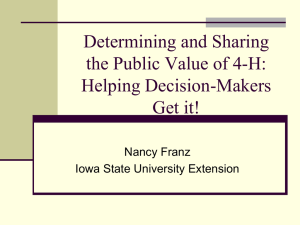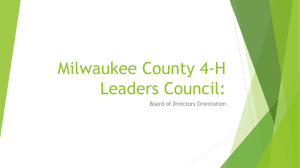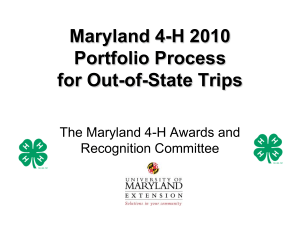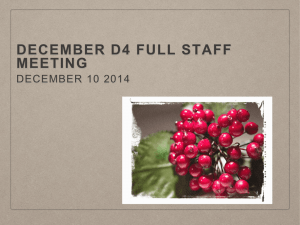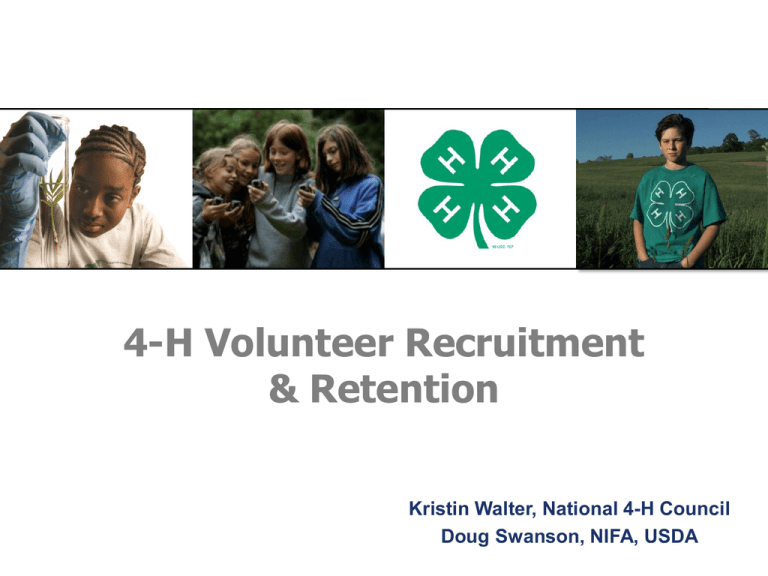
4-H Volunteer Recruitment
& Retention
Kristin Walter, National 4-H Council
Doug Swanson, NIFA, USDA
The Path To Get Here
• NIFA and National 4-H Council partnered to commission
a comprehensive national study among current and
prospective 4-H volunteers.
• Harris Interactive was hired to conduct the two-phased
research project:
One-on-one telephone interviews with volunteer specialists
Online focus group sessions with current 4-H volunteers
Survey of volunteers (both current and prospective volunteers)
• The resulting work was then tested via telephone focus
group session with volunteer specialists.
2
Goals of the Project
• The research sought to explore a number of important
areas:
What drives people to become volunteers
What does a positive volunteer experience look like
What attachment is there to volunteering with 4-H (emotional
and rational factors)
What aspects of the 4-H mission appeal to potential volunteers
Which segments of current and potential volunteers are most
promising (and which are not)
3
This Work Was Made Possible By:
4
4-H Volunteer Segmentation
Methodology
•
•
•
•
•
This survey was conducted online within the United States
Field Dates: August 16-September 10, 2010
Totals: 2771 total completes split into three groups:
4-H Sample (N=1024)
Current volunteers (N=1506), U.S. adults 18+ who have volunteered in
the last year.
Future volunteers (N=241), U.S. adults 18+ who plan to volunteer in the
next year.
Sample for current and future volunteers came from the Harris Poll online
database and were weighted for age, sex, race/ethnicity, education, region
and household income to be representative of the US general population of
adults 18+. Propensity score weighting was also used to adjust for
respondents’ propensity to be online.
The 4-H sample came directly from 33 state 4-H programs.
Executive Summary
• Current and future volunteers tend to volunteer for the same kinds of
organizations as do 4-H volunteers, though in smaller numbers. Yet,
these groups volunteer less than 4-H volunteers do, and less than
they’d reportedly like to volunteer.
• While 4-H, current and future volunteers values related to volunteering
are similar, 4-H’ers actual experience comes much closer to that ideal
than does the volunteering experience of current volunteers.
• Majorities of all groups agreed that organizations focusing on “life
skills” would be most effective in benefiting the country, employers and
the economy. Further, relatively few agree that young people today are
learning the life skills they need to reach their full potential.
Executive Summary
• Familiarity with 4-H is low compared to other organizations in the
competitive set, however favorability and trust were measured
closer to the competitive set.
• Top of mind descriptions of 4-H continue to reflect the historical
origins of the organization – with majorities of current and future
volunteers citing “agriculture/animal husbandry” first.
In contrast, 4-Hers first mention the focus on education and not
the content of that education.
• The proportion who are likely to volunteer for 4-H nearly doubles
after learning a little about the organization
Conclusions/Recommendations
• Focus on getting the right message out about the
organization – more education about how and why you
do what you do and less on the specific subject areas
• Leverage “word of mouth” as method of recruitment –
via current, and future participants as well as local
organizations, churches, schools, etc.
Conclusions/Recommendations
• Leverage the current national discussion on education - position
4-H as an organization/way for young people to develop life skills
that everyone believes are important and needed and relatively few
actually think young people are getting
• Provide more opportunities for episodic volunteering – current
volunteers more likely to describe positive volunteering as “giving
back to the needy” perhaps suggesting a shorter term, instant
impact event (i.e. serving meals in a soup kitchen) rather than
having a longer-term impact. Diverse opportunities may help get
people in the door to learn about 4-H.
Steer people into different kinds of opportunities based on their
interests and motivations
Volunteer Segmentation
Segmentation Parameters
• Attitudes toward 4-H
Familiarity
Favorability
• Skill sets
• Motivation for volunteering
Recommendations
Segment
How familiar?
How favorable?
How motivated?
How much do
they volunteer
already?
Our
Recommendation
1
High
High
Medium
High
Recruit for
leadership/
volunteerism
2
Medium
Very Low
Medium
High
Recruit for
volunteerism
3
Medium
Medium
Low
Medium
Recruit for
volunteerism
4
Low
Low
Low
Medium
Recruit/
Educate
5
Low
Very Low
Low
Low
Educate
6
Low
Low
Low
Low
Ignore
7
Low
Low
Very Low
Very Low
Ignore
8
Very Low
Very Low
Very Low
Low
Ignore
Volunteer Engagement & Activation
Resource (VEAR)
14
Volunteer Segments
Medium Potential
Source: Harris Interactive Segmentation Study, September 2010
Volunteer Engagement & Activation Resource
Prime Targets
COMMON MOTIVATORS
• Teach kids enduring life skills
• Have a positive impact on the next generation
• Apply what I’ve learned through hands-on experience
KEY MESSAGES
•Your can have a positive impact on the next generation in
your community by sharing your experience and knowledge.
•Help fuel the extraordinary efforts of our youth by joining the
Revolution of Responsibility
Segment Details
17
Transformational Leaders
Primary Motivators
Want to be leaders/mentors for future generations
Like working with young people
Believe in the importance of teaching life skills
Like having longer-term engagements
Want to build relationships with kids
Like to set an example
4-H Relationship
Extremely familiar with 4-H (72%)
Extremely favorable to what 4-H offers (70%)
1/3 say it never occurred to them to volunteer with 4-H
Demographics
70% Female and 49% are 50+
Live in urban/suburban areas
Spend a lot of time volunteering already (26.7 hrs./month)
Most ethnically diverse segment (24% Black, 9% Hispanic)
Lifestyle Interpretation
Active lifestyles
Experiences over things
Highly organized
Care about multiple causes Invest in what they believe in
Natural leader, responsible
Connected/in the know
Transformational Leaders
8%
Primary Motivators
Key Messages
•Want to be leaders/mentors for future
generations
•Like working with young people
•Believe in the importance of teaching life skills
•Like having longer-term engagements
•Want to build relationships with kids
•Like to set an example
•Commit to leading the next generation by
teaching them how to make a meaningful
contribution
•Join the Revolution of Responsibility happening
right now in your community and every
community in the country
Touch Points*
Community: Libraries, church, restaurants, grocery stores, gardening stores, parks
Online: MapQuest, photo share sites, recipe sites, medical sites, travel sites
TV: Weather channel, FOX news, CNN, Food Network, Lifetime, HGTV, Hallmark, NCIS
Magazines: AARP, Better Homes and Gardens, Good Housekeeping
Other: AM radio, direct mail to home
*Source: MRI Fall 2010 (activities/interests of women 50+ who have volunteered in the past 12 months)
Linked Ins
Primary Motivators
Like to share their experiences/make an impact
Want to apply what they’ve learned
Like action and fun
Inclined to episodic and virtual volunteering
4-H Relationship
Low familiarity with 4-H
62% have volunteered with youth organizations in the past
Interest in 4-H rises when learn more about organization
Demographics
58% Male
Highest educated (84% college+) – skills in SET
Highest income segment
High concentration of <50-year-olds
Highest representation of Hispanics at 16%
Already volunteering about 22 hours/month
Lifestyle Interpretation
Highly engaged parents
Attend church regularly
Life revolves around their
children
Volunteer at child’s school
Draw on own childhood
High value on family time
Linked Ins
Primary Motivators
Key Messages
•Like to share their experiences/make an impact
•Want to apply what they’ve learned
•Like action and fun
•Inclined to episodic and virtual volunteering
•Apply your (SET) passions to the next generation
•Make a contribution for positive change in your
community
•Take an active part in the Revolution of
Responsibility in your community
Touch Points*
Community: Restaurants, fitness centers, parent events, kids sports, home shows
Online: Facebook, YouTube, Weather.com, Google Maps/MapQuest, Amazon, Wikipedia, gmail, ESPN
TV: Discovery, History, ESPN/ESPN2, TBS, TNT, Comedy Channel
*Source: MRI Fall 2010 (activities/interests of men 25-49 with college degrees who have volunteered in the past 12 months)
3%
Traditionalists
Primary Motivators
Interested in learning new skills
Like working with different generations
4-H Relationship
Average familiarity with 4-H (53%)
Above average favorability to what 4-H offers (62%)
4-H is already highly visible in their community
Demographics
32%rural residents
51% are 50+
66% Female
Least educated segment (46% HS grad or less)
Work/job responsibilities are an obstacle for volunteering
but do so 18 hrs./month
Lifestyle Interpretation
Practical people
Blue-collar
Economic pressure
Bargain shoppers
Willing to roll up sleeves
Community is important
Traditionalists
• Primary Motivators
• Interested in learning new skills
• Like working with different generations
15%
• Key Messages
• Learn, grow and work with the next generation
• Join the Revolution of Responsibility happening
right now in your community
Touch Points*
Community: Libraries, church, restaurants, grocery stores, gardening stores, parks
Online: MapQuest, photo share sites, recipe sites, medical sites, travel sites
TV: Weather channel, FOX news, CNN, Food Network, Lifetime, HGTV, Hallmark, NCIS
Magazines: AARP, Better Homes and Gardens, Good Housekeeping
Other: AM radio, direct mail to home
*Source: MRI Fall 2010 (activities/interests of women 50+ yrs who have volunteered in the past 12 months)
Active Mentors
Primary Motivators
Want to pass on the skills they’ve learned in life
4-H Relationship
Average familiarity with 4-H (47%)
Average favorability to what 4-H offers (49%)
Demographics
Fairly equally balanced men/women
Oldest segment (52% are 50+)
Many retired (31%)
Beginning to have more time to volunteer than others
Average volunteering 17 hrs./month
35% are rural residents
Lifestyle Interpretation
Active grandparents
Experience has given them
Loyal church-goers
strong opinions
Concerned about kids today –
don’t have skills needed
Active Mentors
• Primary Motivators
• Want to pass on the skills they’ve learned in life
20%
• Key Messages
• Leave a legacy of responsibility in your
community
• Use your skills to push our country forward
• Empower kids with your knowledge by joining
the Revolution of Responsibility happening right
now in your community
Touch Points*
Community: Church, community banks, gardening stores, parks, traditional American events, hair salons,
barber shops, insurance agencies
TV: Weather Channel, Fox News, CNN, Lifetime, Hallmark, Macy’s Thanksgiving Day Parade
Magazines: AARP, financial magazines
Online: None
Other: AM radio, direct mail to home, coupons
*Source: MRI Fall 2010 (activities/interests of men 50+ yrs who have volunteered in the past 12 months)
Generation Next
Primary Motivators
Want to teach skills to kids/be a mentor
4-H Relationship
Not very familiar with 4-H (30%)
Demographics
70% Female
Youngest segment (41% 18-29 yrs.) (40% 30-49 yrs.)
On the verge of starting families, many students in this group
Fairly diverse group (15% Black, 12% Hispanic)
Highest concentration of urban dwellers (35%)
Low volunteering pattern (12 hrs./month)
Lifestyle Interpretation
Parents-in-training
Working at first “real” job
Trying to figure it all out
Have many priorities
Believe the future will be
better than the past
Altruistic –improve the world
Care about a variety of issues
Generation Next
• Primary Motivators
• Want to teach skills to kids/be a mentor
18%
• Key Messages
• Use your skills to help kids explore and discover
what matters to them so they can make an impact
today and for the future
• Use your experience to fuel the Revolution of
Responsibility happening right now in your
community
Touch Points*
Community: church, school related activities, parades, grocery stories, fitness centers, pet stores/vets
Online: Facebook, YouTube, Weather.com, MapQuest, Amazon, Wikipedia
TV: Food Network, A&E, Lifetime, ABC Family, TLC, HGTV, Disney, E!, Academy Awards
Magazines: People, Better Homes & Gardens
Radio: Contemporary and urban FM stations
*Source: MRI Fall 2010 (activities/interests of women 25-49 who have volunteered in the past 12 months)
Sideliners
Primary Motivators
Not very interested in youth-related organizations
Prefer episodic volunteering
Don’t believe volunteering can open doors to opportunities
4-H Relationship
Low familiarity with 4-H (45%)
Low favorability of 4-H (44%)
Committed to what they are already doing
Lowest SET skills
Demographics
Low volunteering pattern (12 hrs./month)
60% Female, 56% are <50 years old
70% White
Lower education levels (44% HS or less)
Lifestyle Interpretation
Weekend volunteers
Having fun is a priority
Volunteering is social activity
Giving back is a “duty”
Backgrounders
Primary Motivators
Not very interested in youth-related organizations
Not at all interested in mentoring
Uninterested in learning new skills through volunteering
Don’t believe volunteering can open doors to opportunities
4-H Relationship
Low familiarity with 4-H (39%)
Low favorability of 4-H (42%)
Demographics
Lowest rate of volunteering (6 hrs./month)
Highest concentration of rural residents (37%)
Least diverse ethnically (81% White)
55% Male, 45% Female
47% are age 30 to 49, 47% are 50+
Lifestyle Interpretation
Live in a small town
Self-sufficient
Focused on neighbors
Less religious
Low interest in volunteer
attributes
Many are retired
Pre-Occupieds
Primary Motivators
Not very interested in youth-related organizations
Not interested in mentoring
Not motivated by being involved in youth hands-on learning
4-H Relationship
Low familiarity with 4-H (19%)
Low favorability of 4-H
Committed to what they are already doing
Demographics
Low volunteering pattern (11 hrs./month)
Highest post-graduate educated (24% post-graduate)
65% White
64% male, 59% are <49 years old
Lifestyle Interpretation
Demanding jobs
Less inclined to support
Pulled in multiple directions
children’s activities
No regular schedules – hard for
them to commit
How To Use This Resource
• Use the segments to identify the types of
volunteers you are attracting
• Let the provided key messages for each
segment guide the direction you take with each
person you are trying to recruit
• Focus your time on recruiting the most
promising candidates
• Blend the knowledge provided by this research
with the National 4-H brand campaign – Join
the Revolution of Responsibility!
31
The Answer
Young people in 4-H are uniquely
prepared to step up to the challenges
of a complex, changing world.
Brand Essence Video
Portland Video
Campaign Materials
www.4-H.org/revolution
How to use these materials
• Recruit volunteers
Talk about the impact volunteers can have on youth
and on their communities
Explain how volunteers can “Join” to help positively
impact their communities
Share the chance to be part of an active movement
across the country
• Embed these video(s) on your website, share
them at events
Our Next Steps
• Formally launch the Volunteer Engagement
& Activation Resource (VEAR) and
accompanying web site.
• Begin work to develop the following materials
to continue to aid in the recruitment and
retention of 4-H volunteers:
Provide “elevator speeches” for each segment
Develop a “Frequently Asked Questions”
Provide webinar training sessions to discuss how
to use the research and recommendations
And more…
38
Where to Download This Resource?
www.4-H.org/information-for/educatorsprofessionals
39
Questions?
What additional materials or resources
can National 4-H Council look to create
to help you and your staff?
Other questions?
40
4-H is the youth development program of our
nation's Cooperative Extension System.
41

